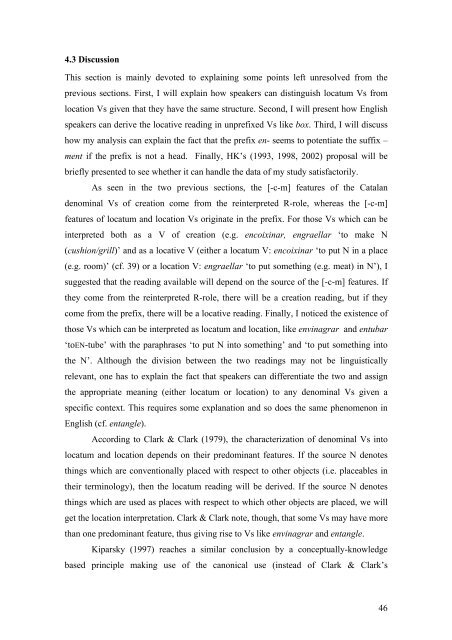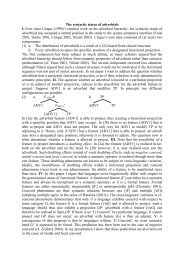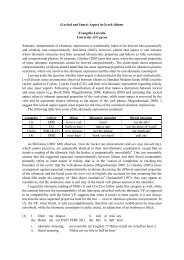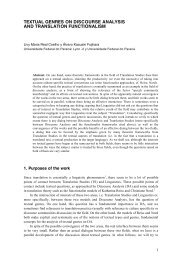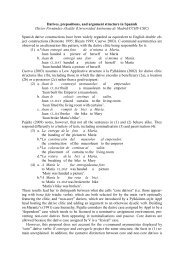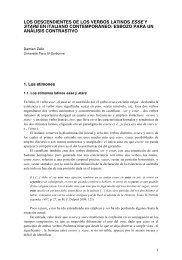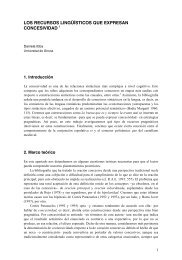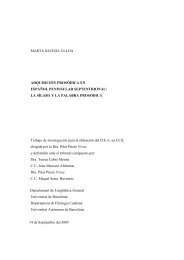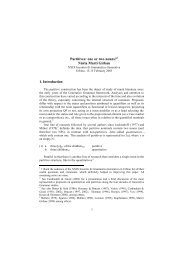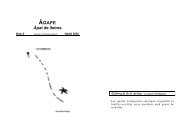Prefixation in English and Catalan - Departament de Filologia ...
Prefixation in English and Catalan - Departament de Filologia ...
Prefixation in English and Catalan - Departament de Filologia ...
You also want an ePaper? Increase the reach of your titles
YUMPU automatically turns print PDFs into web optimized ePapers that Google loves.
4.3 Discussion<br />
This section is ma<strong>in</strong>ly <strong>de</strong>voted to expla<strong>in</strong><strong>in</strong>g some po<strong>in</strong>ts left unresolved from the<br />
previous sections. First, I will expla<strong>in</strong> how speakers can dist<strong>in</strong>guish locatum Vs from<br />
location Vs given that they have the same structure. Second, I will present how <strong>English</strong><br />
speakers can <strong>de</strong>rive the locative read<strong>in</strong>g <strong>in</strong> unprefixed Vs like box. Third, I will discuss<br />
how my analysis can expla<strong>in</strong> the fact that the prefix en- seems to potentiate the suffix –<br />
ment if the prefix is not a head. F<strong>in</strong>ally, HK’s (1993, 1998, 2002) proposal will be<br />
briefly presented to see whether it can h<strong>and</strong>le the data of my study satisfactorily.<br />
As seen <strong>in</strong> the two previous sections, the [-c-m] features of the <strong>Catalan</strong><br />
<strong>de</strong>nom<strong>in</strong>al Vs of creation come from the re<strong>in</strong>terpreted R-role, whereas the [-c-m]<br />
features of locatum <strong>and</strong> location Vs orig<strong>in</strong>ate <strong>in</strong> the prefix. For those Vs which can be<br />
<strong>in</strong>terpreted both as a V of creation (e.g. encoix<strong>in</strong>ar, engraellar ‘to make N<br />
(cushion/grill)’ <strong>and</strong> as a locative V (either a locatum V: encoix<strong>in</strong>ar ‘to put N <strong>in</strong> a place<br />
(e.g. room)’ (cf. 39) or a location V: engraellar ‘to put someth<strong>in</strong>g (e.g. meat) <strong>in</strong> N’), I<br />
suggested that the read<strong>in</strong>g available will <strong>de</strong>pend on the source of the [-c-m] features. If<br />
they come from the re<strong>in</strong>terpreted R-role, there will be a creation read<strong>in</strong>g, but if they<br />
come from the prefix, there will be a locative read<strong>in</strong>g. F<strong>in</strong>ally, I noticed the existence of<br />
those Vs which can be <strong>in</strong>terpreted as locatum <strong>and</strong> location, like env<strong>in</strong>agrar <strong>and</strong> entubar<br />
‘toEN-tube’ with the paraphrases ‘to put N <strong>in</strong>to someth<strong>in</strong>g’ <strong>and</strong> ‘to put someth<strong>in</strong>g <strong>in</strong>to<br />
the N’. Although the division between the two read<strong>in</strong>gs may not be l<strong>in</strong>guistically<br />
relevant, one has to expla<strong>in</strong> the fact that speakers can differentiate the two <strong>and</strong> assign<br />
the appropriate mean<strong>in</strong>g (either locatum or location) to any <strong>de</strong>nom<strong>in</strong>al Vs given a<br />
specific context. This requires some explanation <strong>and</strong> so does the same phenomenon <strong>in</strong><br />
<strong>English</strong> (cf. entangle).<br />
Accord<strong>in</strong>g to Clark & Clark (1979), the characterization of <strong>de</strong>nom<strong>in</strong>al Vs <strong>in</strong>to<br />
locatum <strong>and</strong> location <strong>de</strong>pends on their predom<strong>in</strong>ant features. If the source N <strong>de</strong>notes<br />
th<strong>in</strong>gs which are conventionally placed with respect to other objects (i.e. placeables <strong>in</strong><br />
their term<strong>in</strong>ology), then the locatum read<strong>in</strong>g will be <strong>de</strong>rived. If the source N <strong>de</strong>notes<br />
th<strong>in</strong>gs which are used as places with respect to which other objects are placed, we will<br />
get the location <strong>in</strong>terpretation. Clark & Clark note, though, that some Vs may have more<br />
than one predom<strong>in</strong>ant feature, thus giv<strong>in</strong>g rise to Vs like env<strong>in</strong>agrar <strong>and</strong> entangle.<br />
Kiparsky (1997) reaches a similar conclusion by a conceptually-knowledge<br />
based pr<strong>in</strong>ciple mak<strong>in</strong>g use of the canonical use (<strong>in</strong>stead of Clark & Clark’s<br />
46


